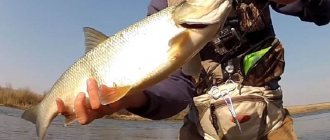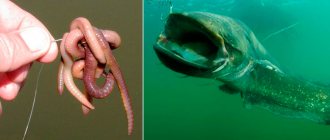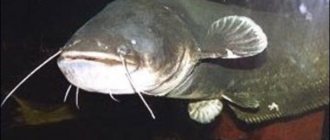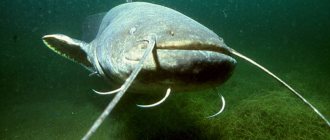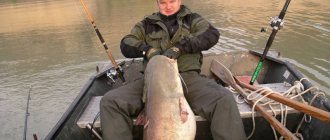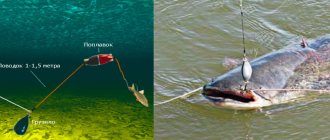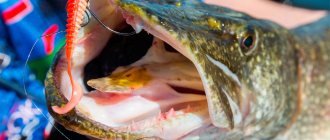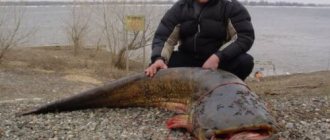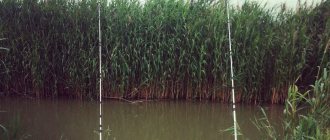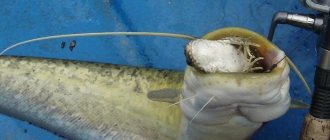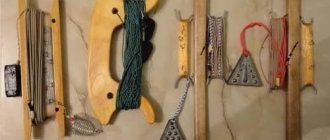When using such bait, you can always count on a catch, but do not forget about heavy artillery, such as fried sparrow or poultry offal. Some fishermen use sausage and bloodwort as bait. And this is not surprising, since blood certainly attracts catfish. In fishing stores you can buy blood-scented boilies. On some bodies of water, such baits turn out to be the most effective.
Catfish is a predatory fish that can feed on a variety of foods of animal origin. This predator has a fairly large mouth, so the size of the bait does not play a significant role. Although, when catching small or large catfish, you have to select bait of the appropriate size. There are different baits, both commonly used and exclusive ones, which catfish love, but are difficult to get.
Depending on the season, the use of bait does not have a certain consistency. For fishing to be effective, you should take into account the seasons and select the appropriate baits.
Catfish hooks are large and with increased strength, usually numbers from 10 to 40 from different companies. Some fishermen place live bait on several stings at once, piercing it in different places. The risk of loss of expected production is significantly reduced.
Habitats of freshwater baleen
Finding the areas where these fish live and feed is an important part of catching them. The catfish does not belong to the schooling species of living silver and loves to hide:
- in deep-sea holes and snags;
- near the rubble of submerged trees and logs;
- close to bridge supports.
The fish shows its presence by rising to the surface, which cannot be confused with the behavior of other inhabitants of the river or lake - the water surface suddenly spins like a noisy wheel, hiding the ruler of the bottom in the whirlpool. Having discovered its vital activity, you need to choose the right equipment for fishing.
4. Sparrows. These small birds are first roasted over a fire and then skewered on a hook. Catfish often bite on this type of bait, perhaps because the birds are a delicacy for river predators. Sparrows are caught for fishing using special traps. If you catch several birds, you can be sure that a couple of large catfish will definitely “bite” on such bait.
Fishing calendar by fishing season
- Winter . Of course, you can catch it, but it will be a labor-intensive process. Therefore, many anglers prefer not to do this at this time of year. You need to have accurate data about his rookery and place a well-chosen bait there, then this will be possible.
- Spring . When the water warms up to 8ºС, it begins to show active activity. It leaves the holes in shallow water and begins to actively move in search of food. At this time, it is necessary to use inactive baits: worms, rotten meat, offal, etc. When it gets warmer and the water reaches 15ºC, he begins to really eat, and will eat everything that gets into his mouth.
- Summer . When the water temperature rises to 20ºС, spawning begins; it lasts on average about 20 days. During this period, he cannot be tempted by any known bait; he will not be caught. After spawning, the feeding begins again, and it lasts for a week and a half. After eating, he again becomes inactive during the day. An exception can only be before or after a thunderstorm. You need to hunt only at night, or at dawn.
- Autumn . With the onset of rain and sudden cold snaps, it is not possible to determine his mood. Until the end of autumn it can still sometimes be seen in the shallows. But then he goes to his winter refuge and leaves it less and less often. At this time they hunt for large spinning baits.
Summer bait for catfish
During the summer, various living creatures actively reproduce in the water, so catfish do not have problems with food. During this period, predators prefer to lie down on the bottom during the daytime, and go hunting at night or in cloudy weather. Many anglers say that the best time to catch catfish is in the fog.
In July - August, this predatory fish bites best on the following baits of animal origin: live bait, locusts, mollusks, frogs and crawlers.
Important! Frogs can be thrown into the water not too far - the catfish will swim up to them on its own. But for live bait fishing, it is better to use a long rod to cast the bait as far as possible.
- silicone baits;
- wobblers;
- spinners (spinners and spoons).
Some of the baits we buy are quite strange at first glance, but they are much easier to get and the catfish take them well:
Each season has its own preferred catfish baits. Properly selected bait can provide a stable bite, and, if you’re lucky, an excellent catch.
Spring
After winter sleep, along with the warming of the water, the catfish gradually become more active. In April, when the water temperature rises to 8-10° Celsius, you can start hunting for the mustachioed giant. Large specimens in spring respond more readily to bait in the afternoon. The bite in mid-spring is still very unstable: frequent bites can alternate with complete calm.
When the water warms up to 18° Celsius, catfish spawn. Soon (after a short lull) the eating begins.
The list of baits that catfish bite on after hibernation is very diverse. Among the most common and effective spring baits for catching a mustachioed predator:
- crawling worms;
- live bait;
- fried sparrow;
- pearl barley;
- chicken liver;
- frogs;
- crayfish.
It is important to try different bait options to identify the preferences of the predator at a particular time and in a particular place, but it is better to start spring fishing for freshwater giants by using worms as bait, and only then experiment with other baits (live bait, crayfish and frogs).
Summer
The maximum activity of catfish occurs in summer, namely in its second half. In warm weather it is more active at night, and in rainy, cold or foggy weather it can peck at any time. Often, in search of food, catfish leave their burrows in shallow water. Trophy specimens prefer to be in quiet pools.
The choice of summer baits for catfish is impressive, since due to its activity it swallows almost everything. Indiscriminately. In addition, in the summer there are no problems with getting this or that bait. The preferred baits are those that form the basis of the daily diet.
The best summer baits for catfish:
- small bird;
- pieces of fish;
- live bait;
- shellfish;
- frogs
- crawls;
- locusts;
- any large insect.
The fishing method and casting distance depend on the bait you choose. For example, live bait can be used for long casts, as can a bunch of crawlers. You won’t be able to throw a frog far - it is suitable for short casts.
Autumn
- cancerous necks;
- fried sparrow;
- live bait;
- chicken offal;
- crawls;
- blood sausage or boilies with the smell of blood;
- frogs;
- shellfish
When fishing for catfish, it is advisable to cast several tackles with different baits. When there is a bite, for example on crawlers, it is recommended to change the bait for them on all tackles. This suggests that the mustachioed giant prefers this particular bait at a given time.
Winter
During the winter months, the catfish does not leave its hole, actually freezing. The chances of successful fishing are negligible. You can tempt a predator to bite with the help of bright bait. It responds best to live fish, especially asp and rudd. Such live bait is able to move energetically in cold water, attracting the attention of a predator. An alternative option for winter catfish fishing is fishing with lead heads.
When catching catfish with a spinning rod, you need to look for catfish throughout the reservoir, just as when catching perch. If within half an hour there are no catfish bites at a promising place, move on to the next one. At each site, try a variety of baits to figure out the catfish's preferences and eventually start catching the bait that is most attractive to it.
Artificial baits for spinning fishing
There are many artificial baits for spinning; the list of them can take a very long time. But the most catchy ones for the mustachioed predator are wobblers, spinners and silicone.
Wobbler
Rapala Countdown Magnum 22
There are floating wobblers - they are equipped with a blade and have an average diving depth. Great for the summer season, near the dams of huge rivers. After darkening, the barbels swim into shallow water, in places where small things accumulate.
They drive the wobblers in jerky movements, pausing so that the bait can float up. The barbel always bites when the wobbler starts moving again. The length of the wobblers should be 20 cm. Rapala Countdown Magnum 22
Sinking - when the temperature drops in the fall, catfish move to deeper layers, and that’s where you need to look for them. The best bait at this time will be wobblers, sinking with a semi-passive game. Postings must be done slowly. Hunting at this time:
- rivers - in whirlpools, next to the harbor.
- lakes - in deep-sea places. A very good wobbler from Rapala Magnum.
The fish is inactive at this time, and therefore you need to give it a little rest by stopping the bait.
Silicone
Large edible and inedible silicone fish (10-25 cm) are suitable for spinning, especially in spring and autumn. At this time it lies in the bottom layers.
On the river, silicone is used in whirlpools near dams, at the confluence of two rivers, etc.
In lakes - at depth, near catfish shelters. Barbel has a good sense of smell, so the fish should not have a pungent synthetic smell. You can treat it with purchased flavorings, or keep it in a bag with fish for a couple of days.
Spoon
Barbels are very tempted by the loud sound of bait. For night hunting, a heavy spoon, for example, a two-layer Effzett, is suitable. It makes noise when lowering and a clicking sound when moving.
To explore a place and fish, you can throw the bait into the same place 20-30 times without worrying about the noise it makes. This individual bites on a noisy bait only after it has been repeatedly lowered into the water.
When using this wiring technique, you need to pay special attention to the speed of regaining control of the nozzle. Because when hunting for a lure, the bite can begin almost immediately after casting.
In order not to lose control of the bait, when casting you need to slow down the flight a little. This will ensure instant hooking when biting.
Spinning baits for catfish
A few words about spinning bait for catfish. The following baits are excellent for this purpose:
- vibrators;
- turntables;
- wobblers;
- jig.
When catching catfish with a spinning rod, you need to look for catfish throughout the reservoir, just as when catching perch. If within half an hour there are no catfish bites at a promising place, move on to the next one. At each site, try a variety of baits to figure out the catfish's preferences and eventually start catching the bait that is most attractive to it.
Fish holes and edges, whirlpools and whirlpools. Focus on catfish splashes or catfish funnels. The easiest way to identify a catfish is by its activity on the surface of the water.
Tap the bottom with a variety of baits and the catfish will definitely bite if one of the baits is attractive enough for it. When fishing for catfish, it is best to work with a jig and have a powerful rod and strong fishing line.
Good luck with your catfish fishing and - no tail, no scales!
Cloudflare Ray ID: 63a989495d9d4bf5 • Your IP: 195.64.208.251 • Performance & security by Cloudflare
The size of the hook depends on the size of the bait. When using live bait weighing 30-100 g, you can use single hooks No. 8-10. If the fishing is carried out for the meat of shells, worms, bird giblets, then hook No. 6 is suitable. And when the live bait is large, it is better to use a rig of two hooks.
Techniques and tactics for catching catfish
Wiring parameters - measured, unhurried movements of the rod:
- The wobbler needs to be buried no more than 30-40 cm from the bottom.
- Jig fishing - take edible or inedible silicone fish and heavy spoons.
- When casting, they are caught with silicone baits and oscillating spoons.
- Trolling - diver wobblers.
In particularly intense currents, use spinning rods: test 60-150 or more.
In low currents and standing water:
- test - 30-80, heavy class;
- multiplier reel - 5500-6000;
- braid, with breaking load - 15-25 kg.
You can take any bait, for example: foam rubber, silicone fish, various kinds. They should be equipped with a 20-50 g weight at the front.
The principle of wiring is that the bait must pass the bottom in jerky movements.
Make several turns of the coil, followed by a long pause - 10-15 seconds. The bite is a bit like a hook. Only after 7 seconds will the catfish come to its senses and begin to resist. When fishing with a spoon (spoon), the game drags on, it is sluggish and unpredictable, sometimes it needs to be interrupted for 4-7 seconds.
Sometimes a spinner may also be of interest. In small lakes and rivers you can catch it using oscillating spoons. In large areas, catchable ones are deep wobblers with a dive of up to 5 m. At night, use baits moving near the surface of the water.
Favorite catfish lures and best baits
Baits for catching catfish
In the summer, soma can be offered a fairly rich menu.
You can make bait from waste. Fishermen often use offal and singed bird feathers. Homemade baits include the use of squid, live small fish. You can prepare combined baits. Catfish are attracted to the scents of their prey. Leeches are used in the same way.
Large insects become the next catchable bait in the summer . For example, locusts and mole crickets. But acquiring such bait is not easy. Locusts live only in warm regions, massively destroying farmland, and mole crickets are difficult to dig out of the ground. You can look for mole crickets in gardens under the remains of last year's manure.
The mustachioed predator also bites well on live bait . It could be a large fish, frog or crayfish. The best option would be to catch live bait in the same reservoir or river where the catfish is hunted.
If the reservoir is rich in shellfish , then you should use different shellfish as bait. These can be shells, mussels, etc. But first you need to open the shell of the mollusk with a knife, and only then bait the contents onto the hook.
Among the spinning lures wobblers are in favor . Each model has its own diving depth. If you have an echo sounder, it is easy to determine the horizon where the fish are located. After this, select a bait with the appropriate working depth and begin fishing. The insertion of the wobbler should be slow and even.
You can successfully catch a mustachioed predator with large silicone fish equipped with heavy jig heads. When trolling, the bait is moved evenly, and when casting, a stepped retrieve is used.
Traditionally, catfish are also caught using large oscillating spoons , which allow the angler to experiment with playing and deepening the bait.
Som
Due to their physiological state, the vast majority of catfish are located in the so-called wintering pits in winter. There they are partially or completely frozen, which means you can catch it only if you choose the right place for fishing.
To do this in winter is a success, and the significance of which is never diminished by anyone. The angler who achieves this will be respected for many years. Do you want to be a respected fisherman? Then the tips we will present today will be useful to you.
Choosing a place and time for fishing
A catfish pit is one of the most profitable places, because a large number of desired prey live there all winter. They also often choose half-dams, where it is very calm and also has enough food. In most cases, these predatory fish are located near the very bottom, where they wait for their prey.
Other good places to catch a big specimen are small secluded areas near the groins where the fish will also position themselves in the hope of catching some food for themselves. If we have decided on a place, it is important to note that the bite is best at sunset.
Fishing in winter involves the use of different baits and artificial lures, which can cause a huge stir among hungry fish in the evening! This is exactly what we will try to take advantage of. One way or another, we can tell you how to catch catfish in winter, because we have information about its condition in winter, its location in winter and what time of day is best to fish for catfish. Now another question arises: what to fish for?
Bait selection
It is best if the angler uses special silicone baits with a weighted head. In this case, the bait will quickly and easily sink to the very bottom, where there are a lot of fish. If we talk about the length of the bait, it varies from 10 to 17 centimeters. The color of the bait depends on the body of water in which the fish is being fished.
Clear water allows you to use golden and silver baits, while muddy water means using only yellow ones. We also note that shiny baits have proven themselves to be excellent, attracting the attention of a hungry predator faster than others.
Components included in the bait:
Basic methods of catching catfish
There are dozens of different types of fishing. The most popular: fishing rod, spinning rod, coastal donka, quok, etc. You just need to always remember that this fish is bottom-dwelling. This means that the gear is compiled based on the specifics of bottom fishing.
Na kwok
There are different types of kwok.
Kwok is a kind of mallet, hitting the water with it will produce characteristic gurgling sounds. It is made from a variety of materials: wood, metal and mixtures. If you wish, you can buy a ready-made, factory-made one, of various designs.
Such a blow resembles a loud click. The barbel leaves its shelter and immediately heads towards the source of the sound. No one knows for sure what attracts him. Maybe it's just the call of a female, or ordinary curiosity. It is not difficult to master the game of kwok; they make 5-6 strikes on the water with minimal depth. They pause and repeat again. But the best way is to fish from a boat.
Catfish fish only from May until almost the end of September.
To the donka from the shore
You can also catch it from the shore, but not a trophy specimen. If possible, position yourself next to a catfish hole, on the shallows. This will increase your chances significantly. From the shore, throw the bait within the reach of the fish.
- Bottom tackle for catfish
- The donka must be of special strength:
- Leash: Ø 0.2–0.16 mm.
- Monoline: 0.5-1 mm.
- For large individuals, a braid is needed: Ø 0.6–0.9 mm.
- Hooks: No. 10–16, for bait, tees are often used.
- Sinker (sliding): up to 120 g.
- The coil is at least 4000.
Leashes must be attached to a fishing line with a carabiner.
In the spring, large live bait up to 300 grams is used for bait: worms, live bait, loach, gudgeon, crawler. The catfish comes close to the shore, so there is no need to make long casts.
In summer - add locusts, shells, mole crickets and leeches. You need to start hunting only in the dark. Place the fishing rod on the stand, loosen the friction brake on the reel and install a bite alarm.
For spinning
It should be very powerful:
- Length - 2.6-3 m.
- Test - 70-100 g.
- Reel - at least 200 m of line.
- Braid, up to 30 lb.
- For a twister, the cord is 50 lb.
If you have to hunt up to 20 kg, the tackle can be made shorter.
Lures : deep wobblers, spoons, jig baits.
An effective bait is a Super Shad Rap wobbler; during retrieval, it will emit a strong vibration.
Types of bait for catfish
There are many baits, especially of artificial origin: twisters, wobblers, vibrotails, silicone fish, etc.
But despite this, many prefer to use the old fashioned way: worms, live bait, frogs, locusts, etc. And they believe that this is a more affordable and tasty food.
Organic origin
We can highlight:
- Crawling worms (whole bunches) - used by more than one generation of catfish, especially effective for small and medium-sized specimens, in the spring, when it gets warmer.
- The shell is a good delicacy; you can find it in a body of water where there is a current. Large shells are collected and the contents are removed using a knife.
- Scorched or slightly smoked bird carcasses are suitable for hunting large specimens. The bird is very strongly scorched over a fire, until it smells like burnt feathers and flesh. They let it rot and hang it entirely on the hook.
- Pieces of meat and fish - the main thing is that they have a foul odor. In this form, they are cut into pieces of the desired shape and planted.
- Live bait. The word live bait applies to any type of fish. The size is selected according to the dimensions of the catfish. You need to at least approximately imagine the size of the future trophy.
The main condition for live bait is that it must be alive and caught in its own reservoir.
Catfish pose a natural danger to small fish. This means that they will frantically try to escape, and this will attract the predator even more.
Artificial origin
For spinning it is better to use a wobbler, some models:
- Liberty BITE 130F
- Liberty Deep Runner 800F.
Dorado Invader 8F and 7S SalmoPerch P08SDR
They have a good game: uniform, not very fast wiring. A wide variety of colors, very stable in operation.
For jig hunting, baits made from edible silicone are ideal; the choice is simply huge.
All bodies of water have their own unique features, so the choice will depend only on them.
When going on their next fishing trip, experienced fishermen take with them all the bait they have available. As they say, for all occasions.
How to feed catfish?
Good baiting of the place where you plan to catch catfish increases the chances of catching such wary fish.
Catfish is a smart fish and the longer it lives, the more careful it is, so to ensure a good catch you cannot do without bait.
This predator prefers baits of animal origin, so when preparing the bait mixture it is necessary to add components of animal origin.
So, you can use chopped beef or pork skin, intestines, offal and more. It is best to increase the smell of such bait. Therefore, it is better to smoke the components or lightly fry them.
So, you can use other components that are less repulsive: for example, you can add a small amount of roasted geese or chicken feathers to the mixture.
The bait needs to be processed properly and put in the day before the planned fishing. Catfish is a lazy fish and, having once found a place rich in food, it will return to the area more than once, hoping to taste delicious food again.
The pike didn't bite at all that day. Maybe the catfish forced all the toothy ones to hide in their dens. In any case, I found a 400 gram pike in the catfish’s stomach.
How to catch catfish
There are many modern ways to successfully hunt this giant fish. Fortunately, accessible and inexpensive technical equipment for fishing can be purchased at any specialized store. In the description of the article, we will focus on the more common methods, which are easier and cheaper to organize, and in terms of catch results, which will not be inferior to high-tech methods.
The easiest way to catch catfish is with bottom gear, which is point-mounted in promising fish habitats. The installation for catching catfish with a donkey has the lowest material consumption and is easy to implement. To equip the so-called suspension, you will need one and a half dozen meters of nylon cord with a diameter of 1.5–3 mm, a wooden reel, Kevlar leashes from 30 cm long, lead sliding weights, depending on the strength of the current, their weight varies from 100 to 500 grams and a powerful single a hook capable of withstanding a bending load of at least 100 kg.
Fishing with hooks is a passive fishing method and does not require the angler to constantly be present and control the gear. Similar equipment is also used for catching baleen with quok. With this method, catfish fishing is carried out from a boat, pulling bait with a parallel bait with a quok while the fisherman floats downstream. A similar method of semi-passive fishing includes the now popular trolling, when the bait is a deep-sea wobbler or spinner with strong vibration characteristics. In these methods, an important factor is the choice of the correct trajectory of the swimming device.
The fisherman, having presented the bait, constantly monitors the moment of bite and, if necessary, hooks the trophy. An active hunting method includes casting with a spinning rod. Catching catfish on the river in places where it stays is done with jig wiring using large-sized silicone vibrotails. Fishermen use each of the above methods with equal success throughout the entire season of hunting for the freshwater giant, only making adjustments to the fishing conditions in the body of water chosen for this.
How to catch catfish on a donk
When fishing with the bottom method, the main problem of the method is choosing the right location for installing the gear. The specifics of installing a harness require space for tying the gear, which in some cases is additionally ensured by the installation of wooden poles specially prepared for this purpose.
You can catch catfish with bottom gear both from the shore and from a boat. Having found a promising point, they string live bait onto the hook and lower the bait to the bottom, at a distance of 50–70 cm. The cord is tied to branches, cramps, or a pole stuck into the bank or bottom. The rate is left overnight. In the morning, they simply check the gear by lifting it. A fish that takes the bait will hook itself.
Another bottom fishing method involves installing a rubber bottom with five or ten leashes. A braided line of at least 0.3 mm in diameter is used as the main cord. A cut length of one hundred meters is equipped with a model of at least 1 mm thick and 30 meters long. 40 cm leashes are made from braided fishing line with half the diameter. You can also use fishing line with a diameter of 0.5 to 1 mm. The main cord of the donkey is knitted to a post firmly dug into the bank or to a tree trunk through a rubber shock absorber, which can be used as a casing-braided elastic band from a sports expander. The donka is equipped with an alarm, preferably with dual functions, which provide an audible signal and a visual signal, light, since fishing takes place in the dark. The result of the bite will also be a hard self-hooking of the fish, but the shock absorber will save you from breaking the tackle, which over time will tire the powerful trophy and will allow you to fish it out without much difficulty.
Fishing with kwok
In ancient times, fishermen noticed that the river monster is lured to the fishing site by sound and vibration waves, which are created by striking the water with a device called the kwok. The essence of fishing is to move the fisherman on a boat with the current or with the help of the wind with a bait pulled on a cord, lowered into the water column approximately 1/3 or 1/2 from the bottom. By hitting the water with a quok, the angler activates the fish and forces the predator to get out of the shelter. Feeling and seeing the bait, the fish comes out to attack.
Important! Kwok works in three frequent strokes with a break of fifteen seconds throughout the entire trajectory of the promising penetration.
Inactive catfish bait in the form of a fried chick or a toothless shell is used as bait. They are caught both in the light and in the dark.
Spinning fishing
Fishing for river catfish can also be successful using a spinning rod, which is equipped with a powerful reel with a 0.25 mm braided cord and artificial bait. The most effective fishing methods are using large oscillating spinners and silicone vibrating tails.
Important! The spoon is carried over underwater holes and ditches on slow, even retrieves, without pauses or lowering to the bottom.
Silicone baits are equipped with heavy jig heads and using the step-jigging method they break through riffles, dumps and other underwater natural ground anomalies. The bite is felt in the form of a dull strong blow followed by a sharp pull, after which the fisherman must be prepared for a long and grueling struggle based on winding and lowering the cord, the alternation of which brings the fish to complete fatigue.
Trolling
Trolling is carried out from a motorized watercraft using a powerful spinning rod with a weight of 40 to 90 grams and a length of at least three meters. Deep-sea large wobblers such as shad, fet and crank are used as bait. It is desirable that wobblers have their own animation with frequent amplitudes of play and create strong vibration waves. The color factor comes into the background, but at greater depths, acid and red colors will be a priority. The bait is released from the boat at least 50 meters and pulled at slow to medium speeds, allowing the wobbler to dig the bottom with a shovel. Attacks mostly occur at the exit from a pit or ditch. The feeling of a bite is identical to catching with a throw. Fishing does not differ in technique from the fishing method described above.
